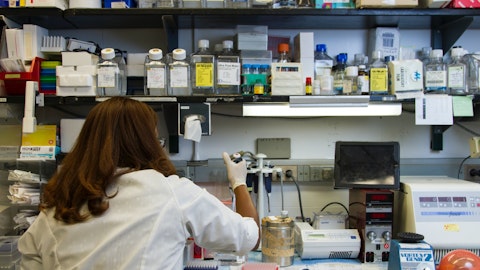That trial is recruiting as we speak and we anticipate that recruitment going through 2024 and into 2025, and we will be able to give understanding of what happened at the interim analysis, the futility analysis as we go through that trial, but we won’t be putting out any efficacy data until at least at a minimum we have enrolled and treated the last patient. With respect to the earlier studies on uzacel in head and neck cancer and in bladder cancer, we anticipate recruiting sufficient patients during that trial to make a — during this year to make a decision around about the end of the year, and we will communicate the basis of that decision being data in a increased number of Phase 1 patients, potentially with some of those in earlier lines and in combination with standard-of-care therapy.
John, do you want to talk to the capacity at the Navy Yard?
John Lunger: Yes, yes, happy to Ad. So, you know, we’ve said that our maximum capacity for internal manufacturing in Philadelphia is around the 600 to 700 patients per year. And while it won’t be necessary to get to that range for the launch, we will have enough capacity to meet both our anticipated clinical and commercial needs for the launch. Enabling this capacity is done through onboarding of staff, manufacturing and quality staff, and we’re executing against that to make sure we have what we need come August.
Yanan Zhu: Great. Thanks for all the color.
Adrian Rawcliffe: Thanks.
Operator: Our next question comes from Graig Suvannavejh of Mizuho Securities. Please go ahead.
Graig Suvannavejh: Hey, good morning. So sorry about that this morning. I do have a couple of questions and congrats on the progress on the quarter. I’m curious, following the approval of Iovance’s TIL base cell therapy. I’m wondering what you think the potential implications may be for you guys, whether it makes things easier, any learnings out of that process that could give some incremental insight into how you think the review for your product will be? And then also on Iovance’s, they were able to get an ICD-10 code as well as a DRG, I think it’s 018 inclusion prior to their approval. Are you expecting something like that for a Afamicel? Thanks.
Adrian Rawcliffe: Thanks, Greg. So with respect to the long anticipated approval of Lifileucel by Iovance’s, we’re quite delighted about that. We think that that heralds the fact that 2024, I think really will be the year where cell therapy becomes a commercial reality for solid tumors with what will be the first two cell therapy launches with the Afamicel coming in August. Now having said that, I think they’re very, very different commercial propositions, melanoma versus synovial sarcoma. But we look forward to Iovance’s doing a great job, because we look to that as indicative of how cell therapies might be adopted in these larger indications. So when you look back in our pipeline, you’ll see many such larger indications where we anticipate cell therapy has the opportunity to change the standard-of-care and be transformative for patients.
And so I have answered the experience in this large melanoma indication, I think will be really instructive. And we are — we believe that rising tide lifts all boats in this regard. So we’re very excited to see what they’re able to do. With respect to the DRG code, confirm you’re right. We anticipate the same code for a Afamicel.
Graig Suvannavejh: Great, and If I could ask a follow up just on the PRAME opportunity, obviously a lot of interest in that target. How are you guys assessing the competitive landscape in PRAME right now?
Adrian Rawcliffe: So I’m going to ask Jo, our Chief Scientist Officer to take a stab at that and talk about that and our differentiation of our PRAME program. Jo?
Jo Brewer: Thanks, Ed. Yes, we’re very excited about PRAME as a target, as the field in general is. I think there’s obviously, we are well aware that there’s lots of competition in this area from bispecifics, as well as cell therapies. But we’re still quite bullish about our own internal program, because we have a strong TCR that was previously partnered with GSK. And we’re looking at ways of taking that forward. So in our own internal analysis where we’ve looked at other competitor products, we think our TCR does have a different safety efficacy profile, which we are very happy with. And we’re also looking at ways of bringing next generation additions to PRAME to actually make it competitive. So we want to look at our TCR for PRAME in multiple different constructs, so that we can choose the best one in the clinic and take that forward.
So we will be — we start with a TCR which we believe has a good safety profile and we’re looking at ways of improving the efficacy for next gen opportunities. And PRAME is a really complementary target to our other programs, both in ovarian with uzacel and other indications. So we’re hoping to leverage our clinical experience in those indications to really push PRAME forward.



